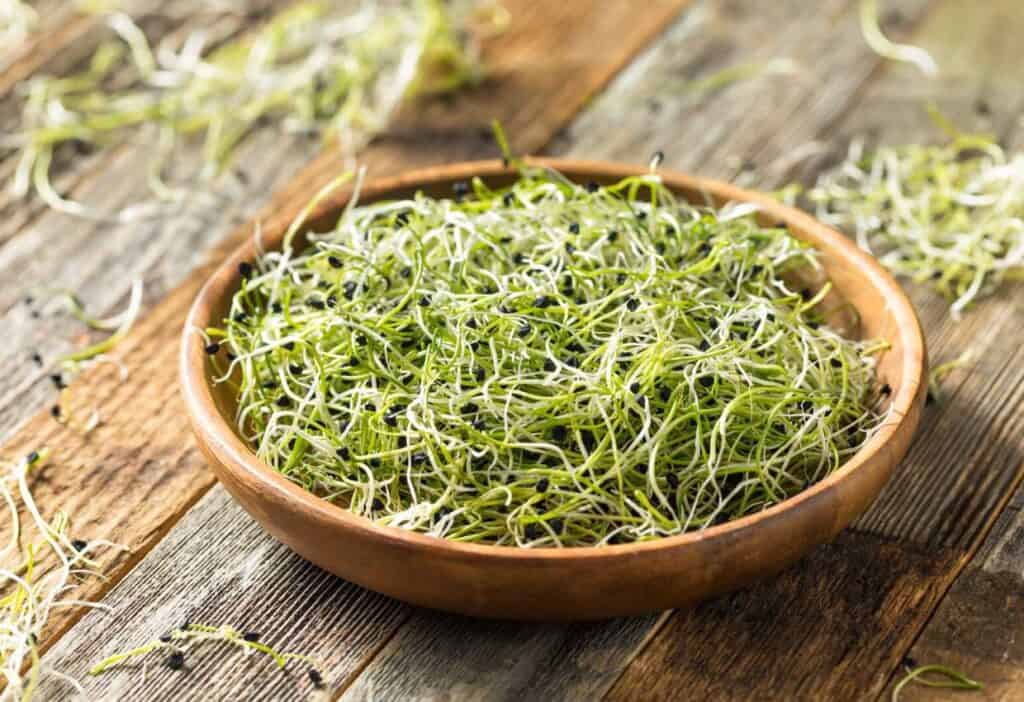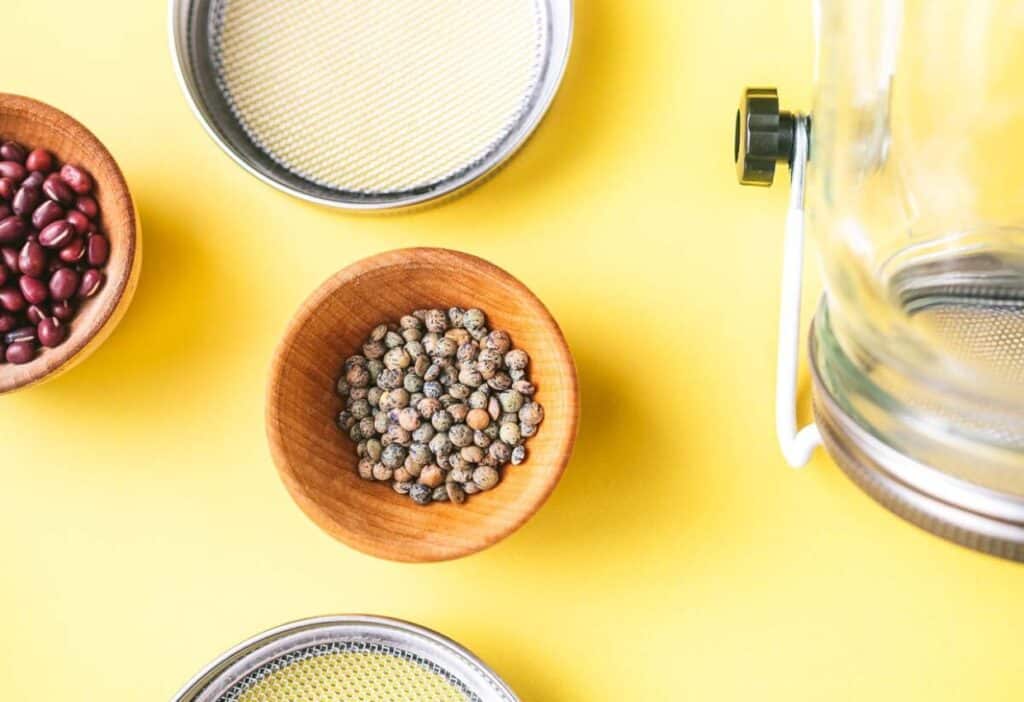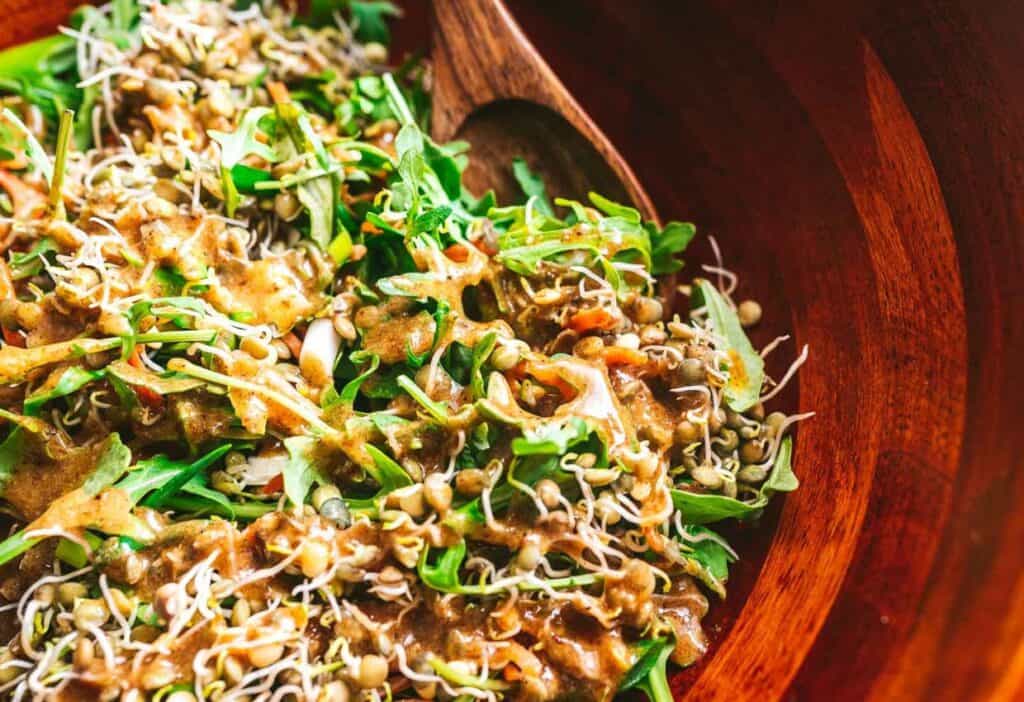Dive into the world of growing sprouts with this step-by-step guide and experience the delight of growing this superfood, packed with essential nutrients, right in the comfort of your own home.

What are sprouts?
Sprouts are young shoots that emerge from seeds and are known for their remarkable nutrient density. They offer a refreshing and crisp texture, along with a range of flavors, making them a versatile ingredient to have on hand. From delicate broccoli sprouts to crunchy lentil sprouts, these young plants offer something unique to any variety of dishes. Their popularity has grown among those seeking a special addition to their culinary repertoire and those looking to incorporate more nutrient-rich foods into their diet. Whether you’re looking to boost the nutritional value of your salads, add a fresh crunch to sandwiches, or introduce a vibrant element to stir-fries, sprouts can provide a satisfying solution.
Sprouts nutrition
Sprouts are a nutritional powerhouse, offering various health benefits that make them a valuable addition to any diet. These tiny shoots boast an impressive nutritional profile, packed with essential vitamins, minerals, and antioxidants. They are an excellent source of fiber, which aids in digestion and promotes a healthy gut. Additionally, sprouts are known for their high levels of vitamin C, providing a natural boost to the immune system. Furthermore, they are rich in enzymes, promoting better nutrient absorption and supporting overall well-being. With their low-calorie content and high nutrient profile, sprouts offer a guilt-free way to enhance your meals while nourishing your body.
Choosing seeds for sprouting
Choosing the right seeds for sprouting is crucial in ensuring success when growing sprouts. Opt for high-quality, organic seeds intended explicitly for sprouting for the best results. Popular choices include alfalfa, mung beans, broccoli, radish and clover seeds. Consider your taste preferences and desired texture when making your selection. Whether you prefer a mild and crunchy sprout or a more robust and peppery one, there is a seed variety to suit every palate. Remember to source your seeds from trusted suppliers to ensure their freshness and purity.
FDL’S 75 Best Bites

Our cookbook with 75 tasty recipes will be your go-to kitchen companion for easy dinners with ad-free recipes right at your fingertips. Crafted by experienced chefs and recipe developers, this collection offers a treasure trove of tried-and-true dishes that make mealtime a breeze.
Get the Recipe: FDL’S 75 Best Bites
Sprouting equipment
To embark on your sprouting journey, you’ll need a few essential items to make the process smooth and efficient. Here’s what you’ll need:
- A wide-mouth jar or bowl for the initial soaking of the seeds is preferable to allow room for the seeds to expand as they soak.
- A mesh lid, also known as a sprouting lid, when using a jar, or a cheesecloth secured with a rubber band, when using a bowl comes in handy for the sprouting process.
- Consider investing in a sprouting stand to hold the jar upside-down while the sprouts grow. This optional accessory helps optimize the sprouting process.
- If you plan to sprout different seeds simultaneously, a tiered seed sprouter can be a practical solution. It allows you to separate the seeds while sprouting them together, providing convenience and organization.
Having these sprouting essentials on hand will ensure that you have the necessary tools to grow healthy and delicious sprouts in your kitchen.

Growing sprouts
When it comes to sprouting, the jar method is the way to go if you plan on consuming the sprouts. Not only is it the most hygienic approach, but it also minimizes the risk of bacteria growth. Follow these steps to sprout seeds using the jar method successfully:
- Begin by thoroughly cleaning all equipment with hot soapy water, ensuring everything is squeaky clean. It’s also important to rinse the seeds thoroughly before starting the sprouting process.
- Find the perfect spot in your home for sprouting. Ideally, it should be a well-lit and airy area, but not in direct sunlight. Good airflow is essential for healthy sprout growth.
- To kickstart germination, soak the seeds in water. Place the seeds in a bowl or jar, and add around three times as much water as there are seeds. Let the bowl sit in a dark spot at room temperature for at least eight to twelve hours.
- After soaking, drain the soaking water, then rinse the seeds two to three times daily with cool water until they sprout. This rinsing process is crucial as it prevents bacteria from proliferating. Maintain a temperature of around 68 F (20 C) during sprouting — warm but not too hot.
- While waiting for the seeds to sprout, ensure there is adequate airflow. Keep them in a jar or container, but ensure they are not too tightly packed. The seeds should remain damp but not overly wet.
- Once the seeds have sprouted, it’s time to harvest them. Most sprouts are ready to harvest after two to three days, but feel free to harvest them whenever you are happy with their size and appearance. Give them a final rinse and drain them thoroughly.
- Before storing, make sure to dry the sprouts. Wrap them in a muslin or tea towel, gently patting them dry. After drying, transfer them to a storage container in the refrigerator.
- Depending on the type of sprout, your homegrown sprouts will keep in the fridge for anywhere from five days to six weeks.
By following these steps, you can experience the joy and satisfaction of growing your own sprouts right at home to have on hand for every meal.

Using sprouts
Sprouts offer incredible versatility and can be enjoyed in a multitude of ways. Whether you prefer them raw, lightly cooked, or blended into dishes, there are endless possibilities for incorporating sprouts into your culinary skill set. Here are some popular ideas for using and enjoying sprouts:
- Add sprouts to your favorite salads for a refreshing crunch and a boost of nutrients.
- Top off your sandwiches with a generous handful of sprouts for an added layer of texture and flavor.
- Incorporate sprouts into wraps or tacos for a vibrant and nutritious twist.
- Stir-fry sprouts along with your favorite vegetables for a colorful and nutrient-packed side dish.
- Blend sprouts into smoothies for a hidden dose of greens and added texture.
- Use sprouts as a topping for soups or stews to add a fresh element.
- Sprinkle sprouts over avocado toast, pizza or bruschetta for an extra layer of taste and visual appeal.
- Mix sprouts into omelets or scrambled eggs for a nutritious breakfast.
- Create a wholesome and satisfying Buddha bowl by combining sprouts with grains, roasted vegetables, and a flavorful dressing.
- Incorporate sprouts into sushi rolls for a unique and healthy twist on traditional rolls.
Experiment with different sprout varieties to discover new flavor combinations and culinary possibilities.
Wrapping it up
Ready to embark on a sprouting adventure? Begin today and witness the fun and fascinating transformation of tiny seeds into vibrant and nourishing sprouts. Cultivate your own superfood, brimming with flavor and packed with nutrients, and experience the true essence of farm-to-fork freshness that only homegrown sprouts can deliver. Get ready to explore the wonders of growing sprouts — an adventure that will truly transform your culinary experience.
Kristen Wood is a photographer, writer and creator of MOON and spoon and yum and The Wonderful World of Sprouts. She is also the author of Vegetarian Family Cookbook, Fermented Hot Sauce Cookbook, and Hot Sauce Cookbook for Beginners. Her work has been featured in various online and print publications, including Elle, Martha Stewart, Yoga Journal and more.